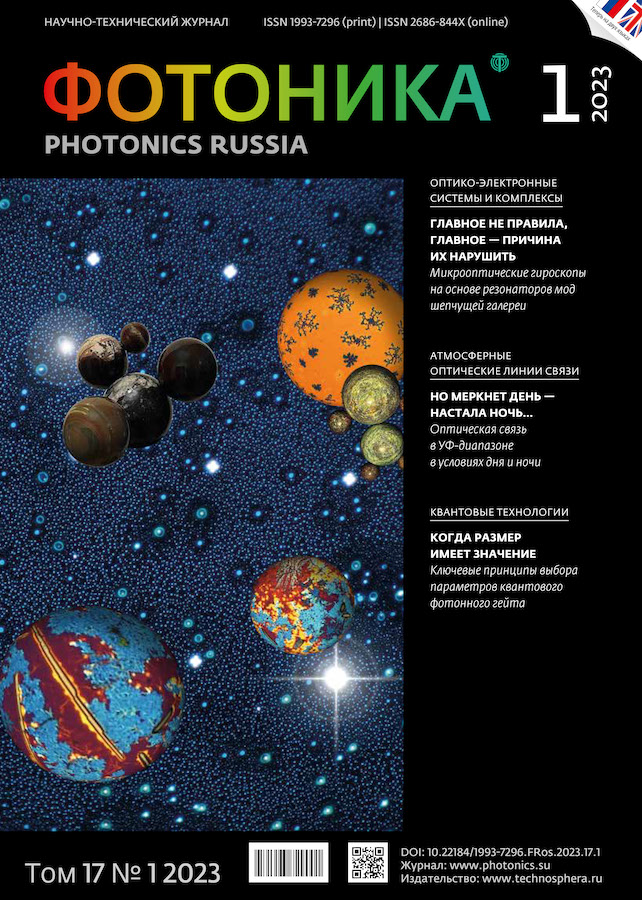Microoptical Gyros Based on Whispering Gallery Mode Resonators
- Authors: Filatov Y.V.1, Kukaev A.S.1, Venediktov V.Y.1, Sevryugin A.A.1, Shalymov E.V.1
-
Affiliations:
- St. Petersburg Electrotechnical University „LETI“
- Issue: Vol 17, No 1 (2023)
- Pages: 26-44
- Section: Optical-Electronic Systems & Complexes
- URL: https://journals.eco-vector.com/1993-7296/article/view/626554
- DOI: https://doi.org/10.22184/1993-7296.FRos.2023.17.1.26.44
- ID: 626554
Cite item
Abstract
Optical gyros, such as ring laser gyros and fiber optical gyros, have become a basis for strapdown inertial navigation systems due to a number of advantages (larger dynamic range of the measured velocities; high stability of scale factor, insensitivity to linear acceleration and G-stress; smaller readiness time, etc.). Despite success in its development, ring laser and fiber optic gyros are unsuitable for using in control systems of small portable devices because of its large size and weight. Now the actual task is miniaturization of optical gyros, or development and research of microoptical gyros.
Full Text
About the authors
Yu. V. Filatov
St. Petersburg Electrotechnical University „LETI“
Author for correspondence.
Email: photonics@technosphera.ru
ORCID iD: 0000-0002-4388-8033
Doctor of Technical Sciences, Professor, Head of Department Laser Measurement and Navigation Systems Department
Russian Federation, St. PetersburgA. S. Kukaev
St. Petersburg Electrotechnical University „LETI“
Email: photonics@technosphera.ru
ORCID iD: 0000-0002-9525-8412
Cand. of Technical Sciences, Associate Professor, Laser Measurement and Navigation Systems Department
Russian Federation, St. PetersburgV. Yu. Venediktov
St. Petersburg Electrotechnical University „LETI“
Email: photonics@technosphera.ru
ORCID iD: 0000-0002-0728-2050
Doctor of Physical and Mathematical Sciences, Professor, Chief Researcher Laser Measurement and Navigation Systems Department
Russian Federation, St. PetersburgA. A. Sevryugin
St. Petersburg Electrotechnical University „LETI“
Email: photonics@technosphera.ru
Cand. of Physical and Mathematical Sciences, Senior Lecturer, Laser Measurement and Navigation Systems Department
Russian Federation, St. PetersburgE. V. Shalymov
St. Petersburg Electrotechnical University „LETI“
Email: photonics@technosphera.ru
ORCID iD: 0000-0002-0731-6978
Cand. of Technical Sciences, Associate Professor, Laser Measurement and Navigation Systems Department
Russian Federation, St. PetersburgReferences
- Filatov Y. V. et al. Microoptical gyros on the base of passive ring resonators. Gyroscopes: Types, Functions and Applications. Nova Science Publishers. New York. 2019.
- Filatov Y. V. et al. Modeling of a ring confocal resonator field. Optical Engineering. 2019; 58(7): 074103.
- Oraevsky A. N. Whispering-gallery waves. Quantum Electronics. 2002; 32(5):377–400.
- Vollmer F., Yang L. Label-free detection with high-Q microcavities: a review of biosensing mechanisms for integrated devices. Nanophotonics. 2012;1(3):267–291.
- Amir R. A., Tindaro I. Effect of Angular Velocity on Sensors Based on Morphology Dependent Resonances. Sensors. 2014;14: 7041–7048.
- Filatov Yu. V., Shalymov E. V., Venediktov V. Yu., Dmitrieva A. D. The comparison of the influence of centrifugal forces and the Sagnac effect on a rotating whispering gallery modes resonators. Proc. SPIE. 2016;9992: 99920A.
- Filatov Yu. V., Shalymov E. V., Venediktov V. Yu. Use of Whispering Gallery Modes Frequency Splitting for Rotation Speed Measurement. Proc. of Advanced Photonics. 2018; SeW4E.3.
- Filatov Yu. V., Kukaev A. S., Shalymov E. V., Venediktov V. Yu. Investigation of a shift of whispering-gallery modes caused by deformations and tensions. Optical Engineering. 2017; 56(10):107104.
- Venediktov V. Yu., Kukaev A. S., Filatov Yu. V., Shalymov E. V. Modelling of rotation-induced frequency shifts in whispering gallery modes. Quantum Electronics. 2018;48(2): 95–104.
- Filatov Yu. V., Kukaev A. S., Shalymov E. V., Venediktov V. Yu. Influence of the whispering-gallery mode resonators shape on its inertial movement sensitivity. Optical Engineering. 2018; 57(1): 014104.
- Filatov Yu. V., Kukaev A. S., Shalymov E. V., Venediktov V. Yu. Study of crosssensitivity of whispering gallery modes in bottle resonators to rotation. Optical Engineering. 2018;57(10): 107107.
- Sumetsky M. Lasing microbottles. Light: Science & Applications. 2017;6(10): e17102.
- Filatov Yu. V., Shalymov E. V., Venediktov V. Yu. Alternating sign bias in the angular velocity sensors on the base of resonators of the whispering gallery modes. Proc. SPIE. 2018;10799: 107990K.
- Bradfield G. Some experiments with barium titanate Il. Nuovo Cimento. 1950;7(2):182–189.
- Mason W. P. Generation of Transverse Vibrations in Liquids. Patent US. 2490452. 1946.
- Filatov Yu. V., Shalymov E. V., Venediktov V. Yu. Passive ring resonator micro-optical gyroscopes. Quantum Electronics. 2016;46(5):437–446.
- Filatov Yu. V., Kukaev A. S., Shalymov E. V., Venediktov V. Yu. Future gyros on the base of whispering gallery mode resonators. Proc. 2017 Progress In Electromagnetics Research Symposium – Spring (PIERS). 2017; 3085–3089.
- Matsko A. B., Savchenkov A. A., Strekalov D., Ilchenko V. S., Maleki L. Review of applications of whispering-gallery mode resonators in photonics and nonlinear optics. IPN Progress Report. 2005; 42: 42–162.
Supplementary files


















